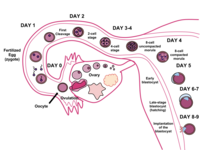
Photo from wikipedia
BACKGROUND Successful embryo implantation is a complex process that requires the coordination of a series of events, involving both the embryo and the maternal endometrium. Key to this process is… Click to show full abstract
BACKGROUND Successful embryo implantation is a complex process that requires the coordination of a series of events, involving both the embryo and the maternal endometrium. Key to this process is the intricate cascade of molecular mechanisms regulated by endocrine, paracrine and autocrine modulators of embryonic and maternal origin. Despite significant progress in ART, implantation failure still affects numerous infertile couples worldwide and fewer than 10% of embryos successfully implant. Improved selection of both the viable embryos and the optimal endometrial phenotype for transfer remains crucial to enhancing implantation chances. However, both classical morphological embryo selection and new strategies incorporated into clinical practice, such as embryonic genetic analysis, morphokinetics or ultrasound endometrial dating, remain insufficient to predict successful implantation. Additionally, no techniques are widely applied to analyse molecular signals involved in the embryo-uterine interaction. More reliable biological markers to predict embryo and uterine reproductive competence are needed to improve pregnancy outcomes. Recent years have seen a trend towards 'omics' methods, which enable the assessment of complete endometrial and embryonic molecular profiles during implantation. Omics have advanced our knowledge of the implantation process, identifying potential but rarely implemented biomarkers of successful implantation. OBJECTIVE AND RATIONALE Differences between the findings of published omics studies, and perhaps because embryonic and endometrial molecular signatures were often not investigated jointly, have prevented firm conclusions being reached. A timely review summarizing omics studies on the molecular determinants of human implantation in both the embryo and the endometrium will help facilitate integrative and reliable omics approaches to enhance ART outcomes. SEARCH METHODS In order to provide a comprehensive review of the literature published up to September 2019, Medline databases were searched using keywords pertaining to omics, including 'transcriptome', 'proteome', 'secretome', 'metabolome' and 'expression profiles', combined with terms related to implantation, such as 'endometrial receptivity', 'embryo viability' and 'embryo implantation'. No language restrictions were imposed. References from articles were also used for additional literature. OUTCOMES Here we provide a complete summary of the major achievements in human implantation research supplied by omics approaches, highlighting their potential to improve reproductive outcomes while fully elucidating the implantation mechanism. The review highlights the existence of discrepancies among the postulated biomarkers from studies on embryo viability or endometrial receptivity, even using the same omic analysis. WIDER IMPLICATIONS Despite the huge amount of biomarker information provided by omics, we still do not have enough evidence to link data from all omics with an implantation outcome. However, in the foreseeable future, application of minimally or non-invasive omics tools, together with a more integrative interpretation of uniformly collected data, will help to overcome the difficulties for clinical implementation of omics tools. Omics assays of the embryo and endometrium are being proposed or already being used as diagnostic tools for personalised single-embryo transfer in the most favourable endometrial environment, avoiding the risk of multiple pregnancies and ensuring better pregnancy rates.
Journal Title: Human reproduction update
Year Published: 2020
Link to full text (if available)
Share on Social Media: Sign Up to like & get
recommendations!